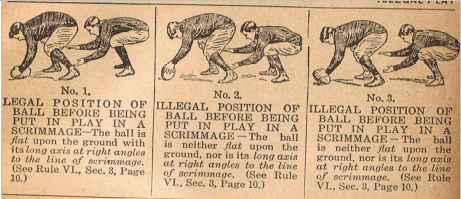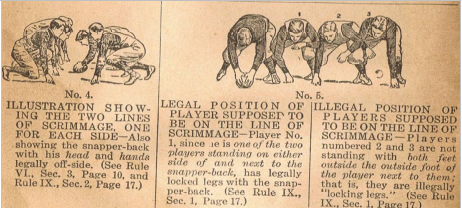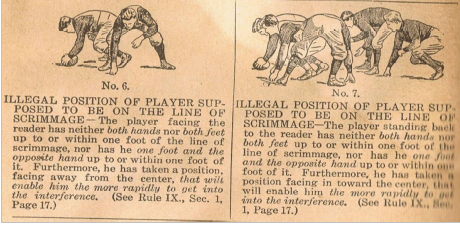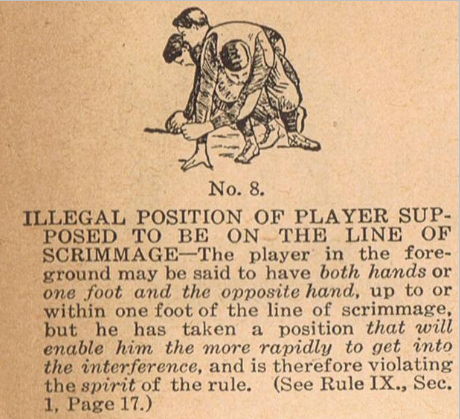The 1921 Foot Ball Rules on the offensive line before the snap set the fundamentals for today's game.
Football History Rewind Part 46
Snapping the ball and other diagrams
Football in 1921 had quite a few different rules and regulations than that of the rules in the twenty-first century. This series has discussed many of them in the past few editions but now we will take it a step further. This article will delve deep into the Spalding’s Official Foot Ball Guide of 1921 and bring the actual sketches from its binding to life once more to demonstrate another aspect of the game in the early 20's. The reader should remember that even though the Guide represents NCAA rules of the time these were the same rules that most high schools and even some professional teams used as well during this era. They are the foundational rules of the game created for football’s breeding ground, collegiate football.
Positioning of the ball before the snap - 1921

Figure 1 shows three frames of what was legal and illegal for 1921 in the way the ball was positioned in regards to the ground before the snap. Notice that the ball had to lay flat on its long axis in regards to the ground. It had to be positioned just as it would sit naturally on the turf as if no one or thing was supporting it. The ends if the ball had to be perpendicular to the line of scrimmage. The box in Figure 1, labeled “No. 1" shows what a legal ball position would be. “No. 2" and “No. 3" were examples of what not to do with the ball prior to the snap.


It is interesting to look at the sketches a little deeper than merely for referencing the rule on ball positioning prior to the snap but to get a glimpse into the past. The first thing a modern football person would notice is the gear of the players for that era. This aspect of the sketches should not be a surprise to anyone who reads this series or the ones written prior. It is fairly common knowledge that for instance the players did not wear helmets of any type in early football.
The rules of the NFHS are a bit more lax than the NCAA rules of 1921 in respect to this aspect of football. Today’s rules would allow Figure 1 - No.3 as legal activity in regards to the ball’s position.
An item that is somewhat new to us is how the quarterback is positioned to receive the snap from center. Notice that unlike most quarterbacks that receive a hand to hand snap in our era, this QB is crouched down almost like a baseball catcher and his hands are out stretched in anticipation of getting the ball but are in no way contacting the center. It could be assumed that this must have led to many loose balls as a result of bad snaps when compared to the modern style. It also probably resulted in more stumbling and sacked quarterbacks in the early days as a QB had the extra burden of getting upright to move after getting the ball. Timing in football is critical and losing that half second could have been disastrous for offenses.
Line positioning at the snap
Figures 2, 3 and 4 represent the sketches from the 1921 rules book in regards to legal and illegal lineman positioning prior to the snap.

Figure 2's “No. 4" give a wing view of how the opposing lines should look at the line of scrimmage. “No. 5" gives an example of legal positioning in 1921 for the center and guard but illegal positions by the tackle and end due to interlocked legs. The NFHS Football Rules of 2007 are in line with this sketch. Rule 7-2-2 states:
“The players on each side of and next to the snapper may lock legs with the snapper, but any other A lineman must have each foot outside the closest foot of the player next to him at the snap.”
Figures three and four also depict illegal formation activity prior to the snap in 1921. These no-nos in 1921 are also illegal in the modern NFHS rules as well. NFHS rule 2-32-9 affirms offensive line man positioning by stating:
“A lineman is any A player who is facing his opponent’s goal line with the line of his shoulders approximately parallel thereto and with his head or foot breaking an imaginary plane drawn parallel to the line of scrimmage through the waist of the snapper . . . ”
The wording of the 1921 rules and those of the common era may be a bit different but the basic rules of how a lineman is to properly set himself remain the same over the span of the eight decades from which each rule book was written. What is shown as illegal in the 1921 sketches labeled Figure 2, 3 and 4 are just as illegal today. The positioning of a lineman has lasted the test of time and will most likely last many decades into the future.
Please look back soon for more example of 1921 sketches in the next edition of this series.
Credits
FIgures drawn and displayed in the 1921 Spalding's Foot Ball Guide for proper and inproper snapping position of the ball.






